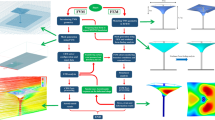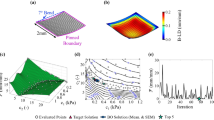Abstract
While aortic valve root compliance and leaflet coaptation have significant influence on valve closure, their implications have not yet been fully evaluated. The present study developed a full fluid–structure interaction (FSI) model that is able to cope with arbitrary coaptation between the leaflets of the aortic valve during the closing phase. Two simplifications were also evaluated for the simulation of the closing phase only. One employs an FSI model with a rigid root and the other uses a “dry” (without flow) model. Numerical tests were performed to verify the model. New metrics were defined to process the results in terms of leaflet coaptation area and contact pressure. The axial displacement of the leaflets, closure time and coaptation parameters were similar in the two FSI models, whereas the dry model, with imposed uniform load on the leaflets, produced larger coaptation area and contact pressure, larger axial displacement and faster closure time compared with the FSI model. The differences were up to 30% in the coaptation area, 55% in the contact pressure and 170% in the closure time. Consequently, an FSI model should be used to accurately resolve the kinematics of the aortic valve and leaflet coaptation details during the end-closing stage.







Similar content being viewed by others
References
Astorino M, Gerbeau JF, Pantz O, Traoré KF (2009) Fluid–structure interaction and multi-body contact: application to aortic valves. Comput Method Appl Mech Eng 198:3603–3612
Carmody CJ, Burriesci G, Howard IC, Patterson EA (2006) An approach to the simulation of fluid–structure interaction in the aortic valve. J Biomech 39:158–169
Chandran KB (2010) Role of computational simulations in heart valve dynamics and design of valvular prostheses. Cardiovasc Eng Technol 1:18–38
Conti CA, Votta E, Corte AD, Viscovo LD, Bancone C, Cotrufo M, Redaelli A (2010) Dynamic finite element analysis of the aortic root from MRI-derived parameters. Med Eng Phys 32:212–221
De Hart J, Baaijens FPT, Peters GWM, Schreurs PJG (2003) A computational fluid–structure interaction analysis of a fiber-reinforced stentless aortic valve. J Biomech 36:699–712
De Paulis R, De Matteis GM, Nardi P, Scaffa R, Buratta MM, Chiariello L (2001) Opening and closing characteristics of the aortic valve after valve-sparing procedures using a new aortic root conduit. Ann Thorac Surg 72:487–494
Degroote J, Swillens A, Bruggeman P, Haelterman R, Segers P, Vierendeels J (2010) Simulation of fluid–structure interaction with the interface artificial compressibility method. Int J Numer Method Biomed Eng 26:276–289
Dumont K, Stijnen JMA, Vierendeels J, Van De Vosse RN, Verdonck PR (2004) Validation of a fluid–structure interaction model of a heart valve using the dynamic mesh method in fluent. Comput Methods Biomech Biomed Eng 7:139–146
Grande-Allen KJ, Cochran RP, Reinhall PG, Kunzelman KS (2000) Re-creation of sinuses is important for sparing the aortic valve: a finite element study. J Thorac Cardiovasc Surg 119:753–763
Grande KJ, Cochran RP, Reinhall PG, Kunzelman KS (1998) Stress variations in the human aortic root and valve: the role of anatomic asymmetry. Ann Biomed Eng 26:534–545
Griffith BE, Luo X, McQueen DM, Peskin CS (2009) Simulating the fluid dynamics of natural and prosthetic heart valves using the immersed boundary method. Int J Appl Mech 1:137–177
Haj-Ali R, Dasi LP, Kim HS, Choi J, Leo HW, Yoganathan AP (2008) Structural simulations of prosthetic tri-leaflet aortic heart valves. J Biomech 41:1510–1519
Katayama S, Umetani N, Sugiura S, Hisada T (2008) The sinus of valsalva relieves abnormal stress on aortic valve leaflets by facilitating smooth closure. J Thorac Cardiovasc Surg 136:1528–1535
Kim H, Lu J, Sacks MS, Chandran KB (2008) Dynamic simulation of bioprosthetic heart valves using a stress resultant shell model. Ann Biomed Eng 36:262–275
Kobs RW, Chesler NC (2006) The mechanobiology of pulmonary vascular remodeling in the congenital absence of eNOS. Biomechan Model Mechanobiol 5:217–225
Kobs RW, Muvarak NE, Eickhoff JC (2005) Linked mechanical and biological aspects of remodeling in mouse pulmonary arteries with hypoxia-induced hypertension. Am J Physiol Heart Circ Physiol 288:1209–1217
Lai YG, Chandran KB, Lemmon J (2002) A numerical simulation of mechanical heart valve closure fluid dynamics. J Biomech 35:881–892
Makhijani VB, Yang HQ, Dionne PJ, Thubrikar MJ (1997) Three-dimensional coupled fluid–structure simulation of pericardial bioprosthetic aortic valve function. ASAIO J 43:M387
Morsi YS, Yang WW, Wong CS, Das S (2007) Transient fluid–structure coupling for simulation of a trileaflet heart valve using weak coupling. J Artif Organs 10:96–103
Nicosia MA, Cochran RP, Einstein DR, Rutland CJ, Kunzelman KS (2003) A coupled fluid–structure finite element model of the aortic valve and root. J Heart Valve Dis 12:781–789
Peskin CS (2002) The immersed boundary method. Acta Numer 11:479–517
Rankin JS, Dalley AF, Crooke PS, Anderson RH (2008) A ‘hemispherical’ model of aortic valvar geometry. J Heart Valve Dis 17:179–186
Sacks MS (2003) Incorporation of experimentally derived fiber orientation into a structural constitutive model for planar collagenous tissues. J Biomech Eng 125:280–287
Shadden SC, Astorino M, Gerbeau JF (2010) Computational analysis of an aortic valve jet with Lagrangian coherent. Chaos 20:017512
Soncini M, Votta E, Zinicchino S, Burrone V, Fumero R, Mangini A, Lemma M, Antona C, Redaelli A (2006) Finite element simulations of the physiological aortic root and valve sparing corrections. J Mech Med Biol 6:91–99
Sotiropoulos F, Borazjani I (2009) A review of state-of-the-art numerical methods for simulating flow through mechanical heart valves. Med Biol Eng Comput 47:245–256
Thubrikar M (1990) The aortic valve. CRC Press, Boca Raton
Van Loon R (2005) A 3D method for modeling the fluid–structure interaction of heart valves. Ph.D thesis, Technische Universiteit Eindhoven
Wang SH, Lee LP, Lee JS (2001) A linear relation between the compressibility and density of blood. J Acoust Soc Am 109:390–396
Weinberg EJ, Mofrad MRK (2007) Transient, three-dimensional, multiscale simulations of the human aortic valve. Cardiovasc Eng 7:140–155
Yoganathan A, Chandran K, Sotiropoulos F (2005) Flow in prosthetic heart valves: state-of-the-art and future directions. Ann Biomed Eng 33:1689–1694
Acknowledgments
This work was partially supported by a Grant from the Nicholas and Elizabeth Slezak Super Center for Cardiac Research and Biomedical Engineering at Tel Aviv University. The second author acknowledges the support from the European-Union Marie-Curie IRG grant.
Author information
Authors and Affiliations
Corresponding author
Rights and permissions
About this article
Cite this article
Marom, G., Haj-Ali, R., Raanani, E. et al. A fluid–structure interaction model of the aortic valve with coaptation and compliant aortic root. Med Biol Eng Comput 50, 173–182 (2012). https://doi.org/10.1007/s11517-011-0849-5
Received:
Accepted:
Published:
Issue Date:
DOI: https://doi.org/10.1007/s11517-011-0849-5




